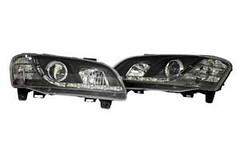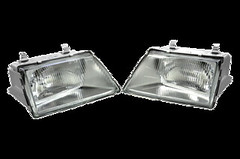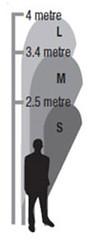The Holden Commodore
has come quite a way and has been Australia's supreme choice for cars and for
years and each current model promises a better version than the previous one,
being the perfection of safety guidelines and vehicle efficacy. From the first
representative of the
Holden Commodore with the introduction
of the VB version, the entire Australia had no doubt that this fresh vehicle was
something special. This innovative version of Commodore was built employing the
Opel platform. Littler than the outgoing HZ Kingswood model, the car was
designed to be more fuel efficient due to the oil scare of the 1970’s. The
Commodore introduced an innovative angular style with the VB
Commodore headlights introducing a square look as opposed to the usual circular lights of
the former HQ and HZ models. Plus, the VB Holden Commodore broke away from
regular car forms by being longer and rectangular.

The
transition to the next model in the series, VC did not see any real significant
changes in terms of styling. The headlights and tail lights of the VC Commodore
models had not been altered from its predecessor model.. The only minimal visual
changes to the VC were an advanced grille plus repositioned front badge. When
the VH model was advanced into the market, there were a few alterations in
design from prior models.This involved new front guards, and the VH also
received reshaped Commodore headlights and Commodore tail lights.The VH
Commodore appeared wider and longer due to the changes in design from prior
models. The newer VH Commodore tail lights in particular were constructed around
the Mercedes Benz models of the day with a stylish louvered design.
The
VK Commodore encountered many changes than its prior models.The newer model
received a 6 window glass house to make the VK Commodore look larger and this
seemed to work with an increase in sales.The three horizontal panel adaptation
to the grille also lent itself to a soar in sales. The VK Commodore's headlights
and clear corner lamps did not alter any revisions from the VH model. This model
did substitute adjustments in the tail lights by converting to horizontal lines
going through each of its lamps.
On the VL Commodore, its adjustments
were mainly observed by its front end of the vehicle. The VL Commodore
headlights were especially changed to a more rounded design. There were not many
changes to the tail lights, for they changed originating on the model. The VL
Berlina introduced dark tinted tail lights, while the VL Calais came out with
white strips being painted upon the upper half of each tail light.
The
progression to the second generation Commodore, embarked with the VN Commodore
was a monumentous transition for Holden. Building the VN Commodore still on the
Opel model, it did encounter some changes like widening and stretching this
distinct model.

The VN
Commodore lights were not what they had been from earlier models. Formerly
promoting the primary amber turn signals, these were soon replaced by the now
more commonolder models, the amber turn signals were updated No longer did
Commodore utilize amber turn signals, these were replaced, and clear headlight
were utilized instead, and also with its turning signals.There were upgrades to
VN Commodore's tail lights, which had a boxier design and modification in tint,
depending upon what model. To state one example, consider the VN Calais, for it
had white stripes instead, dashing across the centre of its tail lights. The VL
Commodore continued with this same white stripes for its model's tail lights.
Holden went above and beyond with its VN Commodore, for there was no
Commodore that could outdo it. Holden had abandoned the abundant size car design
in the previous generations, but it went back to the larger, family-size car,
prevailing as Australia's first choice in family cars. VN Commodore was such a
victory that Holden stayed close to its design when it manufactured the VP
Commodore.Only minor cosmetic changes were visible as Holden had placed invested
much to upgrade funds into investing on improving the performance and efficiency
of the VP Commodore engine range but also making improvements to the chassis.
External changes involved slightly redesigned VP Commodore headlights. The
VP Commodore's headlights underwent transformations by elongating the corner
lamps, making the car look much longer and sophisticated. The VP Commodore's
tail lights were also upgraded, however still maintained the same overall look
as the VN Commodore. The most obvious change on the VP Commodore was its chrome
highlights on its Calais model, and the Berlina's external metamorphose were its
new grey stripes. The VR Commodore when made public was a huge step forward for
Holden. Approximately about 80% of the sheet metal was replaced from the VP
Commodore. The front and rear ends of the VR Commodore cultivated the most
changes from older versions.The headlights were replaced an easier rounder look
and retained the clear corner lamps, and the tail lights also received the same
treatment with a rounding of the VR Commodore tail lights. The tail lights also
were in two pieces with a garnish that was fastened into the boot lid.
The VS Commodore was distributed with least of to the most successful VR
design. The VS Commodore headlights stayed the same, however the VS Commodore
tail lights acquired clear indicator lamps.What a distinction the clear
indicator lamps made for the VS Commodore, for it lent itself a brilliant look
than its previous versions. The VT Commodore's release into the market was
widely applauded, for Holden topped itself once again, surpassing its rival, the
Ford Falcon.The VT Commodore headlights kept the softer round look brought out
by the VS Commodore, and the VT Commodore tail lights gave prominence to a
circular design to compliment the rounder and wider rear end of the VT
Commodore.There were two separate designs of the VT Commodore tail lights with
the series 2 model receiving clear indicator lamps..
Since the VT Commodore
was so well liked and well made, the VX Commodore sustained very few
changes.Like the VT Commodore, the VX Commodore's tail lights came with two
distinct styles, one of them being a 'teardrop' design.Holden tried something
bold with its head lamps on its sportier models by placing a black reflector,
lending itself a daring look.The Berlina and Calais models of the VX Commodore
were not endowed the teardrop design headlights and instead were given a
sharpened corner as opposed to the rounder fashion of the teardrop lamps. The VX
Commodore tail lights witnessed the centre garnish of the previous VT Commodore
were taken off for base models, however the more sophisiticated Berlina and
Calais models still retained the centre garnish.With the release of the Monaro
model, Holden updated the tail lights on these models. The Monaro model was
updated to a three circle lamp design that was well liked by VT and VX Commodore
car owners.
The third series of Commodores displayed the VY Commodore, which
underwent many changes. The rounder look for the VT and VX Commodores was
abandoned for a more glamourous angular look. The VY Commodore's headlights
encountered a design change by adopting an angular shape, giving it stylish
design. The VY Commodore's headlights did not drop the teardrop design, but
luxury and sporty models did not take on this detail.Holden adopted a new
feature with heavy models by introducing projector lamps to the VY Commodore's
headlights.This gave Commodore a modernized look and was also added to compete
with European luxury cars that were fastly becoming its main competitors. Holden
decided upon a triangular tail light design and removed the centre garnish from
its tail light styles from all its versions.As Holden had done before, models
had different tail light designs, but the variations were minute.
The VZ
Commodore
was the final of the third generation of Commodores, but it was much the same as
the VY Commodore, but its front end was cosmetically redone, and the teardrop
shaped headlights were no longer put on.The grandiose models did not abandon
projector lamps. The Calais' tail lights were upgraded by annexing a darker tint
on the bottom of the tail light.
The VE Commodore was Holden’s leading
recent Commodore since 1997.The VE Commodore was no inexpensive assignment, for
it cost Holden $1 billion to manufacture. The VE Commodore was also altogether
designed in
Australia which
was also a first for Holden.The VE Commodore chose a modernized look than former
models by being created wider, having flared guards, and having the front axle
moved to the right, making the way for a 50/50 weight distribution.
Headlights of the VE Commodore were angular in design, like the VZ
Commodore; however they were fuller size. As done before, Holden had the
sportier models exhibit a black reflector and a projector lamp. The VE Commodore
tail lights were handsomely advanced with luxury models having a more common
European style tail lights, and sporty models, like the SSV, had the black
reflector tail lights and centre lamp, surrounded by chrome.These updates were
well liked by VE Commodore owners.
Moving forward for Holden, the HSV models
of the VE Commodore had a wholly unique rear end sheet metal and tail light
design.This was a repeat perhaps a approach of HSV in specific moving to a more
European design.
 Promotional Pens were the answer
to being the most economical for one's marketing goals. All businesses, no
matter how big, are trying to find the best marketing product for their
financial assets.
Promotional Pens were the answer
to being the most economical for one's marketing goals. All businesses, no
matter how big, are trying to find the best marketing product for their
financial assets. 



 You have
your choice of three different sizes of these banners. The biggest size is four
meters high with an ad space of 3X1 meters. The medium size is 3.4 meters high
and with an advertising space of 2.4X1 meters. The smallest tear
You have
your choice of three different sizes of these banners. The biggest size is four
meters high with an ad space of 3X1 meters. The medium size is 3.4 meters high
and with an advertising space of 2.4X1 meters. The smallest tear  A number of current reports by national advertising businesses suggest that in fact the cost of print production in Brisbane is lower than most areas of Australia.
A number of current reports by national advertising businesses suggest that in fact the cost of print production in Brisbane is lower than most areas of Australia.
